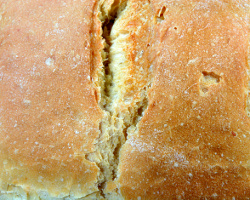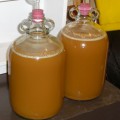Baking bread in the winter – how do you do it?
 We’ve got out of the swing of baking bread recently – partly due to general winter lethargy and partly due to the fact that we’d struggle to get yeast do its thing.
We’ve got out of the swing of baking bread recently – partly due to general winter lethargy and partly due to the fact that we’d struggle to get yeast do its thing.
It would be very difficult to grow a slow rise bread – one that needs a good 12-18 hours to rise. With our woodburners in the office & living room, we get a room temperature of 16-18C (60-65F) for a few hours during the day but for the rest of the time, it is much lower than that. The kitchen is poorly insulated (it’s an addition away from the main body of the house with lots of windows and a hard-to-insulate flat roof) so has frequently been see-your-breath chilly (especially last week when the central heating was out and it was even colder than normal). Opinions differ on the ideal temperature for yeast activity but it’s typically seen as 25-35C (75-95C) – we don’t even come close to that. (Admittedly we rarely come close to that even at the height of summer but it’s warmer, and more consistently warmer, than it is now.)
I’m loathed to use the (electric) oven as a warming box – not only would it be using energy, it would need a lot of management – turning it on and off – since the temperature setting doesn’t go anywhere near low enough for the oven thermostat to manage it. And 12-18 hours of that sort of management isn’t realistic.
Lethargy aside, we would like to get back into baking bread ASAP – it would save a lot of frozen-faced walks to the shop and, of course, shops are going to be closed over the next couple of weekends anyway/out of stock because of snow issues.
We could possibly manage some shorter rise time breads when a woodburning is running – leaving them for longer to account for it still being a bit cool – or even, if I had to do it, in the oven. That’s not out of the question, I’m just a sucker for slow rise bread: I haven’t perfected a non-slow rise loaf recipe yet and I suspect now might not be the time to work on one!
Are you still baking bread at the moment? How are you managing? Have you got any suggestions for things I could try? Or got a fool proof pretty-quick-rising loaf recipe?






We just stick it on a lump of wood near the stove to rise, and turn it every now and then.
“Now and then” is the SI unit of time describing the interval between stove operations including, but not limited to, opening the door to stir the fire, adding fuel, adjusting a vent, discouraging a cat from jumping on top of it.
Perhaps the interior of the oven wouldn’t be such a bad rising place?
If it’s a day you’re baking/roasting anyway, it might be worth risking one loaf to experiment. Have the dough ready to rise when you’re done-wait just a few minutes for it to cool a bit and slide it in, and resist the temptation to peek. I’ve found a shut off oven holds the heat a long time, it dissapates slowly. If I’m wrong…I’ve ruined a batch of bread for you, sorry!
Hmm…or to take out the guesswork, if you have or can borrow an oven thermometer, use it the next time you bake, and when baking is done take a peek every few minutes, to see how fast it cools to bread rising temperature. Someday when you’re in the kitchen a few minutes anyway doing other things.
Then you’d know “Alright, so oven’s off,in ten minute’s the temp’s lowered enough”, you slide in your bread, leave it for the usual rise time, and no wasted energy or babysitting.
I freely admit I’ve never tried this-I hate to be responsible for messing up a batch of bread!
Or…what about the part of the house that’s warm? Could the bread rise in a covered pan there, and be brought to the kitchen when it’s time to bake? Good luck.
Hi bookstorebabe,
I think my line about temperature was unclear – I’ve amended it now – the 16-18C is in the living room & office, the warmest parts of the house*. Earlier this week, I don’t think the kitchen got over about 10C/50F. So even moving it to the warmest bits wouldn’t help that much.
I think I am going to try starting it in the oven when it’s cooling down from something else – I don’t think it’ll hold the heat for more than a couple of hours but that should be enough time to do a short rise loaf or start a slow rise one.
Thanks so much for your suggestions! I don’t mind about messing up a couple of batches of bread trying to figure this out…
* if you ask our cat Boron, he would disagree – he knows the warmest part of the house is under the duvet between John and me. If you asked our other cat Carla, she would say that the warmest part of the house is on top of the dog (a little trick she learnt last week). If you asked Lily-dog, she wouldn’t say anything because she’s a dog and can’t talk ;)
In my rural living days without electricity or central heating, we ate a lot of bannock and other unleavened breads in the cold times.
That’s a very good idea Karen – just skip the rising stage altogether. I’ve not heard of bannock before but I’ll give it a go – and if he doesn’t read this comment and spoil the surprise, I can bake some Irish soda bread for John too. I’ve not tried that before even though he really likes it – I’ll let you know how I get on :)
It probably goes against the frugal grain, but how about a breadmaker? They are temperature controlled and probably quite economical as you are not heating empty space, plus you get the bread to rise inside them-not sure if they heat up at this stage or are just well insulated.Seen them on freegle quite often too.
We did have a breadmaker at one point (a leaving gift when I swapped jobs about 7 years ago) – I think John’s sister has it now. I didn’t like the bread it produced as much as other homemade bread but perhaps we should get it back off her and use it during the chilly months – better to have some not-quite-so-fantastic homemade bread rather than none at all…
A friend of a friend fed me some wonderful homemade bread, and scribbled this on a scrap of paper for me:
3 cups lukewarm water
1.5 tbsp yeast
1.5 tbsp salt
6 cups plain flour
Mix together, leave for 2 hours. “Cloak” the bread and form it into a loaf, let it rise for another 40 mins or so.
Cook at 220 degrees or as hot as your oven will go for about 35 mins.
I know this sounds weird but it does work, and you really don’t have to knead the dough at all, it’s called something like “Artisan bread in five minutes a day” and there are apparently youtube videos about it.
Maybe if you left it right near the burner for the rising period it would do its thing in the few hours that it’s warm enough in your house?
Ooh, another bread recipe to try – Alexis has sent me one too. I like all these alternatives! My favourite bread recipe is a no knead one – I heart lazy baking.
Yes, when Strowger commented about putting his dough nearer the stove, it made me realise that nearer the stove is considerably warmer than the temperature across the room where I sit in a draught!
I’ve been playing with soda bread over the last few weeks – yum! I’ll post the recipe for that soon.
Instead of working against the elements so much try working with them and just make some no-yeast Indian breads, like Missi Rotis, Tandoori Rotis, or something similar, that don’t require yeast. They’re hearty for wintertime, also, and super tasty.
I have the same problem in winter. I used to have an oven with a 100 degree low temp (which was also great for making yogurt or dehydrating) but my current oven only goes down to 170. My solution has been to put it in the microwave with the light on (either inside or underneath seems to work).